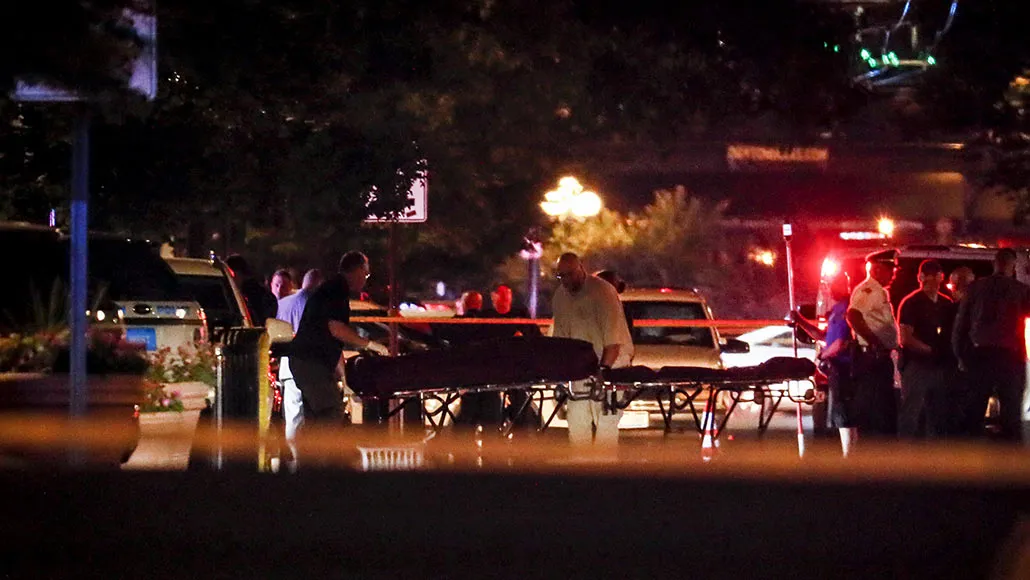
SEEKING ANSWERS Concern over recent mass public shootings, including this one in Dayton, Ohio, August 4 that left 10 people including the gunman dead, may inspire a scientific focus on practical ways to prevent such attacks rather than trying to understand perpetrators’ backgrounds and motives.
John Minchillo/ASSOCIATED PRESS
Two decades ago, two students opened fire at Colorado’s Columbine High School, killing 12 of their classmates and a teacher before turning their guns on themselves. In the aftermath, psychologist James Garbarino interviewed one of the shooters’ parents and brother, in hopes of understanding why a troubled young man would carry out such carnage.
But Garbarino came up empty. “It’s very hard to see how any one thing led to the Columbine event,” says Garbarino, of Loyola University Chicago. In fact, 20 years after that shocking tragedy, there is still no established science to predict who might become a mass shooter (SN: 4/14/18, p. 14). And the attacks keep happening. In the last week alone, there have been several mass shootings in public, including especially deadly attacks in El Paso, Texas, on August 3 and in Dayton, Ohio, on August 4, that left 32 people dead, including the Ohio gunman. The killings have renewed speculation about why certain young males, for the most part, decide to spray bullets across crowded spaces.
But scientists are also now thinking more broadly about the issue. Some say testing a range of public policy approaches to see which best prevent mass public shootings, rather than exploring motives for homicidal rampages, offers the most potential. A preventive research program on public shootings would search for practical policy prescriptions aimed at cutting imminent attacks short.
Researchers need to focus on identifying ways to stop mass shootings before they happen, says Philip Cook, a professor of economics and sociology at Duke University. Mass shooters often communicate threats to others in person or online shortly before acting, researchers have found. So, studies of how best to respond to such threats on social media or in daily life could help to refine proposed “red flag” laws aimed at taking guns from those deemed dangerous, Cook says.
Studies also could explore ways of limiting the tendency of mass shootings to occur in clusters, Cook says, noting that researchers similarly have tracked media coverage of suicides and come up with recommendations to prevent copycat suicides.
“Other lines of inquiry that do not focus on the individual may also be useful,” says Cook, who has studied crime and its prevention since the 1970s. Such research includes tracking links between shootings and vicious political rhetoric, charting trends in hateful and violent online communication, and examining population-wide links between gun violence and the availability of high-capacity magazines.
On an individual level, mass shooters do appear to share certain traits. An analysis of more than 150 mass shootings in the United States from 1966 to 2018 found four commonalities among many perpetrators: childhood violence or trauma, linked to later mental ailments such as depression and anxiety; a work crisis or grievance shortly before the shooting, accompanied by abrupt behavior changes; modeling an attack on what previous shooters had done; and ready access to public shooting sites and guns, often obtaining firearms from family members. Psychologist Jillian Peterson and sociologist James Densley, both affiliated with the nonprofit think tank The Violence Project in St. Paul, Minn., conducted that study, which defined a mass shooting as involving the indiscriminate killing of at least four people in public.
Still, those factors still aren’t enough to predict a mass shooting. Most people with histories of childhood trauma, depression and anxiety, personal grievances and gun access don’t commit crimes, much less mass public shootings. “Even though the problem of mass shootings is enormous, the number of people who commit such acts is so small — a fraction of the population — that untangling a developmental pathway is likely beyond our reach at this time,” says clinical psychologist Theodore Beauchaine of Ohio State University in Columbus.
For now, he says, researchers asked to explain why mass shootings happen need to keep one word in mind: humility. “We know a lot about violent behavior in general, but not about mass shootings.”







